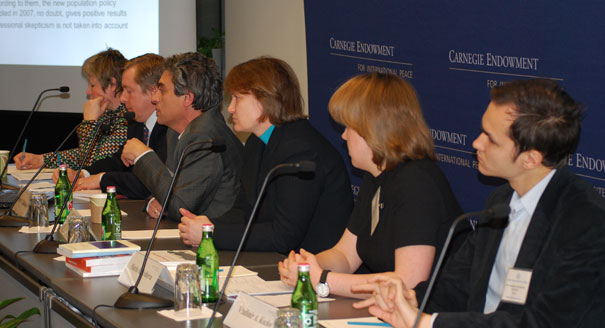Registration
You will receive an email confirming your registration.
IMGXYZ3449IMGZYXRussia has witnessed an unsettling trend of long-term population decline since the mid-1990s, with alarming mortality rate statistics, falling fertility rates, and waves of emigration draining the nation of its best and brightest. Carnegie hosted Russian demographers Sergey V. Zakharov and Vladimir A. Kozlov from Moscow’s Higher School of Economics, Maria A. Avdeeva of the Lomonosov Moscow State University, and Svetlana Y. Nikitina and Anna A. Eremeeva from the Russian Federal Statistics Service in a discussion on Russia’s demographic crisis.
Russia’s Population
The U.S. Census Bureau and Rosstat, the Russian Federal Statistics Service, provide drastically different population forecasts for Russia, with some U.S. projections forecasting a Russian population in 2030 that is smaller by 10 million people than Rosstat’s forecast, Nikitina said.
- Population Bases: This drastic difference in forecasts is due to the initial assumptions of population bases, Nikitina explained. Whereas Rosstat uses about 142 million as the basis for Russia’s population in 2010, U.S. Census Bureau uses a lower number of about 139 million. Rosstat’s basis is more accurate, stated Nikitina.
- Net Migration Rates: In addition, Rosstat assumes a much lower rate of population decrease because it takes into account the net migration into Russia, which numbers about 400,000 labor migrants per year, Nikitina added. The Census Bureau assumes only 40,000 labor migrants per year.
Russia’s Fertility Rate
- Decreases in Fertility Rate: Russia’s fertility rate first plateaued in the turn of the 20th century with about 6.5-7.0 births per woman, which decreased to 1.85-1.90 births per woman by the 1960-1970s, explained Zakharov. Since then, the birth rate has dropped to about 1.6 births per woman.
- Government Policy: Rosstat data are taken as a basis for demographic policy in Russia, said Nikitina. Falling fertility rates worry Russia’s government and garner attention from policymakers, Zakharov added. Policy makers show unfounded optimism in believing that the “fertility problem” can be solved by such tools as monetary incentives offered to families, even though professional demographers are less convinced, said Zakharov.
- “Family Politics”: Russian policymakers view family politics as concerning only families with children, said Avdeeva. As a result, the government provides high direct cash payments, developed day care, and tax reductions to families with children, while policy towards elderly families is relegated to health and retirement sectors.
- No Significant Changes in the Future: Public opinion surveys about the desired and expected number of children support the forecast that Russia’s fertility rate will remain somewhere between 1.5-1.7 births per woman for the foreseeable future, in spite of monetary incentives to have more children, Zakharov added.
Mortality Rate Changes in Russia
Decreasing the current mortality rate in Russia is a challenge and a categorical imperative, said Zakharov. Russia’s life expectancy for both males and females is well below that in other G-8 countries and although infant mortality rate has been decreasing in Russia, it has not yet caught up to rapid decreases of other countries in Europe.
- Optimistic View: Zakharov listed several reasons for taking an optimistic view on a decrease in Russia’s rate of mortality, including:
- A sustained historical downward trend in infant and child mortality;
- Increased effort to fight alcohol consumption;
- Substantially increased public investment in health and programs on hypertension control which seem to have garnered positive results
- Importation of new medical technology actively continues.
- Pessimistic View: Zakharov also saw reasons for pessimism:
- Life expectancy in the elderly population is not increasing.
- The free public health system is deteriorating, and national programs and reforms in public health are chaotic, inconsistent, and often have the character of public relations events, Zakharov said.
Immigration in Russia
In Russia, the disproportion between the vast territory and a shrinking population is increasing, said Zakharov. Sustained growth of the Russian economy is hardly possible without structural upgrades, radically higher returns on human capital, and an increase in immigration.
- Immigration Rate: Around 500,000 net migrants per year are needed to replace losses in Russian population, stated Zakharov. The number of migrant workers in the country is increasing rapidly, with more than two million registered labor migrants in 2010 and as many as six to seven million total labor migrants in Russia, according to the Independent Center of Migration Studies. In 2005, migrant workers constituted 1 percent of the total number of people employed; in 2010, they were 10 percent.
- Ineffective Government Policy: Migration to Russia is complicated by bureaucratic measures initiated by Moscow to combat illegal immigration and a Russian population that has extremely low tolerance for migrants, added Zakharov.
- Human Capital: Existing programs to encourage Russian-speaking and skilled expatriates to come to Russia are ineffective, concluded Zakharov.
Field of Demography
- Education: Currently, there are no bachelors, masters, or PhD degrees available in demographics in Russia. According to Kozlov, demography course are offered as part of economics or sociology degrees at the Higher School of Economics and the Moscow State University, both in Moscow.
- Challenges: The field of demography faces significant challenges in Russia, including a shortage of modern books and qualified educators, said Kozlov. However, positive signs are visible in the recent interest exhibited by the commercial sector, which has started to use demographic and accurate statistics methods, said Kozlov.
